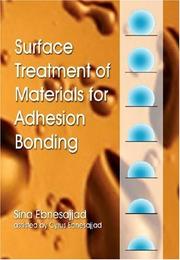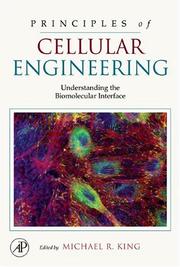| Listing 1 - 10 of 15 | << page >> |
Sort by
|

ISBN: 0824753615 9780824753610 Year: 2006 Publisher: Boca Raton CRC
Abstract | Keywords | Export | Availability | Bookmark
 Loading...
Loading...Choose an application
- Reference Manager
- EndNote
- RefWorks (Direct export to RefWorks)
Adhesion --- Measurement --- Testing
Book
Year: 2006 Publisher: Aberdeen Proving Ground, MD : U.S. Army Research Laboratory,
Abstract | Keywords | Export | Availability | Bookmark
 Loading...
Loading...Choose an application
- Reference Manager
- EndNote
- RefWorks (Direct export to RefWorks)
Coatings --- Adhesion --- Testing --- Standards.

ISBN: 0815515235 9780815515234 9780815519195 0815519192 9781601193582 1601193580 1282253107 9781282253100 9786612253102 661225310X 0080947239 9780080947235 Year: 2006 Publisher: Norwich, NY, U.S.A. : William Andrew Pub.,
Abstract | Keywords | Export | Availability | Bookmark
 Loading...
Loading...Choose an application
- Reference Manager
- EndNote
- RefWorks (Direct export to RefWorks)
This is a unique compilation of surface preparation principles and techniques for plastics, thermosets, elastomers, and metals bonding. With emphasis on the practical, it draws together in a single source technical principles of surface science and surface treatments technologies of plastics, elastomers, and metals. It is both a reference and a guide for engineers, scientists, practitioners of surface treatment, researchers, students, and others involved in materials adhesion and processing. This book describes and illustrates the surface preparations and operations that must be appli
Surfaces (Technology) --- Adhesion. --- Engineering --- Electronics
Book
Year: 2006 Publisher: Aberdeen Proving Ground, MD : Army Research Laboratory,
Abstract | Keywords | Export | Availability | Bookmark
 Loading...
Loading...Choose an application
- Reference Manager
- EndNote
- RefWorks (Direct export to RefWorks)
Fluid mechanics --- Adhesion. --- Particles. --- Cold gases. --- Mathematical models.

ISBN: 0815515235 9780815515234 9780815519195 0815519192 9781601193582 1601193580 1282253107 9781282253100 9786612253102 661225310X 0080947239 9780080947235 Year: 2006 Publisher: Norwich, NY, U.S.A. William Andrew Pub.
Abstract | Keywords | Export | Availability | Bookmark
 Loading...
Loading...Choose an application
- Reference Manager
- EndNote
- RefWorks (Direct export to RefWorks)
This is a unique compilation of surface preparation principles and techniques for plastics, thermosets, elastomers, and metals bonding. With emphasis on the practical, it draws together in a single source technical principles of surface science and surface treatments technologies of plastics, elastomers, and metals. It is both a reference and a guide for engineers, scientists, practitioners of surface treatment, researchers, students, and others involved in materials adhesion and processing. This book describes and illustrates the surface preparations and operations that must be appli
Engineering --- Electronics --- Surfaces (Technology) --- Adhesion. --- Adsorption --- Cohesion --- Materials --- Surface phenomena --- Friction --- Surfaces (Physics) --- Tribology --- Surfaces

ISBN: 3540310495 3540310487 3642068219 Year: 2006 Publisher: Berlin ; New York : Springer-Verlag,
Abstract | Keywords | Export | Availability | Bookmark
 Loading...
Loading...Choose an application
- Reference Manager
- EndNote
- RefWorks (Direct export to RefWorks)
Many plants, animals, and microbes use adhesive polymers and structures to attach to inert substrates, to each other, or to other organisms. This is the first major review that brings together research on many of the well-known biological adhesives. Emphasizing the diversity of biological adhesives and associated adhesion processes, it deals with bacteria, fungi, algae, and marine and terrestrial animals. It bridges a variety of disciplines including biochemistry, molecular biology, biomechanics, bioengineering, microbiology, organism structure and function, and ultrastructure. As we learn more about the molecular and mechanical properties of these adhesives, we begin to understand why they adhere so well and how they develop cohesive strength. With this understanding comes the prospect of developing synthetic or semi-synthetic adhesives with broad applications in areas such as medicine, dentistry, and biotechnology. The book is suitable for both industrial and academic researchers.
Adhesion. --- Adhesives. --- Cell adhesion molecules. --- Cell adhesion. --- Adherence, Cell --- Cell adherence --- Adhesion --- Cell interaction --- Membrane fusion --- Junctional complexes (Epithelium) --- Adhesion molecules (Cytology) --- Adhesion substances (Cytology) --- Cell adhesion substances --- Intercellular adhesion molecules --- Morphoregulatory molecules --- Biomolecules --- Desmosomes --- Hemidesmosomes --- Agglutinants --- Bonding agents (Adhesives) --- Binders (Materials) --- Cement --- Cements, Adhesive --- Glue --- Mucilage --- Adsorption --- Cohesion --- Biochemistry. --- Microreactors. --- Biotechnology. --- Biomaterials. --- Microbiology. --- Biochemistry, general. --- Microengineering. --- Biological and Medical Physics, Biophysics. --- Microbial biology --- Biology --- Microorganisms --- Biocompatible materials --- Biomaterials --- Medical materials --- Medicine --- Biomedical engineering --- Materials --- Biocompatibility --- Prosthesis --- Chemical engineering --- Genetic engineering --- Micro-chemical engineering --- Microchannel reactors --- Microfabricated reactors --- Microreaction technology --- Mini-scale reactors --- Nano-scale reactors --- Chemical reactors --- Biological chemistry --- Chemical composition of organisms --- Organisms --- Physiological chemistry --- Chemistry --- Medical sciences --- Composition --- Biophysics. --- Biological physics. --- Bioartificial materials --- Hemocompatible materials --- Biological physics --- Physics --- Biomaterials (Biomedical materials)

ISBN: 1280745053 9786610745050 1402051298 140205128X 904817290X Year: 2006 Publisher: Dordrecht ; [Great Britain] : Springer,
Abstract | Keywords | Export | Availability | Bookmark
 Loading...
Loading...Choose an application
- Reference Manager
- EndNote
- RefWorks (Direct export to RefWorks)
In this volume, the expression of specific adhesion molecules within human cancer tissues are highlighted. The expression signatures from published DNA microarray and immunohistochemistry studies are detailed. The concept that the alteration of specific adhesion molecules influence the cancer migration ability and cancer damage responses is detailed in this volume; both features are essential for the survival of an invading tumor cell. Defining the minimal adhesion receptors preserved on cancer cells during tumor progression will define the metastatic adhesion signature. Understanding the metastatic adhesion signature will reveal vulnerabilities that could be exploited for the prevention and/or eradication of the invading cancer cell.
Cell adhesion molecules. --- Metastasis. --- Cytoskeleton. --- Cell skeleton --- Skeleton, Cell --- Cytoplasm --- Cancer --- Cancer metastasis --- Dissemination of cancer --- Metastases --- Metastatic cancer --- Neoplasm metastasis --- Spread of cancer --- Tumor dissemination --- Tumor metastasis --- Tumor spread --- Pathology --- Cancer invasiveness --- Cancer of unknown primary origin --- Adhesion molecules (Cytology) --- Adhesion substances (Cytology) --- Cell adhesion substances --- Intercellular adhesion molecules --- Morphoregulatory molecules --- Biomolecules --- Desmosomes --- Hemidesmosomes --- Dissemination --- Metastasis --- Surgery. --- Oncology. --- Medicine. --- Dermatology. --- Oncology . --- Pathology. --- Cancer Research. --- Molecular Medicine. --- Disease (Pathology) --- Medical sciences --- Diseases --- Medicine --- Medicine, Preventive --- Tumors --- Skin --- Clinical sciences --- Medical profession --- Human biology --- Life sciences --- Physicians --- Surgery, Primitive --- Health Workforce --- Cancer research. --- Molecular biology. --- Molecular biochemistry --- Molecular biophysics --- Biochemistry --- Biophysics --- Systems biology --- Cancer research

ISBN: 1280759712 9786610759712 1847350305 9781847350305 1859575242 9781859575246 9781859575246 0981847350305 Year: 2006 Publisher: [Shawbury, Eng.] Rapra
Abstract | Keywords | Export | Availability | Bookmark
 Loading...
Loading...Choose an application
- Reference Manager
- EndNote
- RefWorks (Direct export to RefWorks)
In this review the principles of adhesion are considered first (Section 2). Techniques that have greatly increased our understanding of adhesion to fluoropolymers are described in Section 3. Cases where good adhesion is achieved without a pretreatment are examined in Section 4. However, as pretreatments are usually needed to get the required level of adhesion, this review is mainly concerned with the wide variety of methods available to pretreat fluoropolymers (Section 5). A general discussion and conclusions follow. The report is supported by an extensive bibliography compiled from the Polyme
Adhesion. --- Surface preparation. --- Fluoropolymers. --- Fluorinated polymers --- Fluorine plastics --- Fluorocarbon polymers --- Fluoroplastics --- Organofluorine compounds --- Polymers --- Preparation of surfaces --- Coating processes --- Finishes and finishing --- Sealing (Technology) --- Surfaces (Technology) --- Adsorption --- Cohesion
Book
ISBN: 2802721984 9782802721987 Year: 2006 Publisher: Bruxelles : Bruylant,
Abstract | Keywords | Export | Availability | Bookmark
 Loading...
Loading...Choose an application
- Reference Manager
- EndNote
- RefWorks (Direct export to RefWorks)
Chypre --- Colloques --- Colloquia --- Cyprus --- Europese Unie --- Union européenne --- European Union --- Membership --- Congresses --- European Union countries --- Pays de l'Union européenne --- Relations --- Politics and government --- Congrès --- Politique et gouvernement --- Adhésion --- Europe --- Unité --- Pays de l'Union européenne --- Congrès --- Congresses. --- Unité. --- Adhésion.

ISBN: 9780123693921 0123693926 9780080539638 0080539637 1281186589 9781281186584 9786611186586 6611186581 Year: 2006 Publisher: Amsterdam Boston Elsevier Academic Press
Abstract | Keywords | Export | Availability | Bookmark
 Loading...
Loading...Choose an application
- Reference Manager
- EndNote
- RefWorks (Direct export to RefWorks)
This comprehensive work discusses novel biomolecular surfaces that have been engineered to either control or measure cell function at the atomic, molecular, and cellular levels. Each chapter presents real results, concepts, and expert perspectives of how cells interact with biomolecular surfaces, with particular emphasis on interactions within complex mechanical environments such as in the cardiovascular system. In addition, the book provides detailed coverage of inflammation and cellular immune response as a useful model for how engineering concepts and tools may be effectively applied to com
Manufacturing technologies --- Cell interaction. --- Cell adhesion. --- Tissue engineering. --- Biomedical engineering --- Regenerative medicine --- Tissue culture --- Adherence, Cell --- Cell adherence --- Adhesion --- Cell interaction --- Membrane fusion --- Junctional complexes (Epithelium) --- Cell-cell interaction --- Cell communication --- Cellular communication (Biology) --- Cellular interaction --- Intercellular communication --- Cellular control mechanisms
| Listing 1 - 10 of 15 | << page >> |
Sort by
|

 Search
Search Feedback
Feedback About UniCat
About UniCat  Help
Help News
News